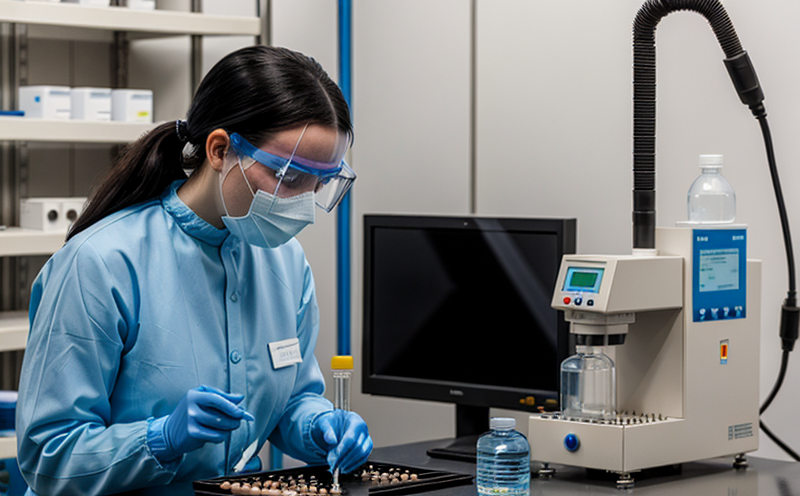USP Specific Impurity Limit Testing
The United States Pharmacopeia (USP) Specific Impurity Limit Testing is a critical analytical procedure used to ensure drug quality and safety by identifying, quantifying, and controlling specific impurities in pharmaceutical products. This testing is essential for compliance with regulatory standards and ensures the integrity of APIs (Active Pharmaceutical Ingredients), excipients, and finished drug formulations.
Specific impurities are substances that are formed during manufacturing processes or can be present as a result of degradation reactions. These impurities may include degradants, by-products, or other compounds that could potentially affect the efficacy, safety, or stability of the pharmaceutical product. USP Specific Impurity Limit Testing helps in understanding these potential risks and ensuring they do not exceed acceptable levels set forth by regulatory authorities.
The testing process typically involves several steps: sample preparation, chromatographic analysis using HPLC (High-Performance Liquid Chromatography), quantification, and validation of the analytical method. The USP sets specific limits for each identified impurity, which must be adhered to throughout the lifecycle of the drug product.
For instance, in a recent study, pharmaceutical researchers found that certain degradation products could lead to increased toxicity if present above the specified limit. This emphasizes the importance of precise and reliable testing methods like USP Specific Impurity Limit Testing. Compliance with these limits not only ensures product safety but also supports successful drug approvals and market entry.
The analytical methodologies employed in this service include advanced HPLC techniques, including UHPLC (Ultra-High-Performance Liquid Chromatography) for enhanced sensitivity and resolution. These methods are validated according to USP General Chapters 1231, 1605, and 1648, ensuring accuracy and reproducibility.
Moreover, this testing is not just limited to API but also extends to excipients and final formulations. It helps in understanding the stability of a drug product over time by monitoring the formation and accumulation of specific impurities during storage or under various environmental conditions. This knowledge is crucial for optimizing manufacturing processes and ensuring consistent quality.
Pharmaceutical companies rely heavily on this testing as part of their quality control measures, R&D efforts, and compliance activities. It provides valuable insights into potential risks associated with impurity profiles and supports the development of safer and more effective pharmaceutical products.
Industry Applications
- API Manufacturing: Ensuring purity levels meet regulatory requirements.
- Excipient Quality Control: Identifying and quantifying impurities in excipients used in drug formulations.
- Formulation Development: Monitoring the stability of final drug products over time.
- Regulatory Compliance: Meeting USP standards for specific impurity limits.
| Industry Segment | Type of Testing Performed | Description |
|---|---|---|
| API Manufacturing | Specific Impurity Limit Test | To ensure API meets USP standards for purity. |
| Excipient Quality Control | Impurity Profiling | To identify and quantify impurities in excipients. |
| Formulation Development | Stability Testing | To monitor the stability of final drug products over time. |
| Regulatory Compliance | Compliance with USP standards | To ensure compliance for specific impurity limits. |
Quality and Reliability Assurance
The quality and reliability of pharmaceutical products are paramount, especially when dealing with complex molecules like APIs. USP Specific Impurity Limit Testing plays a crucial role in ensuring that the impurity profile of a drug product is within acceptable limits as defined by regulatory bodies.
By employing robust analytical techniques such as HPLC and UHPLC, this service guarantees accurate measurement and identification of specific impurities. The use of validated methods ensures consistency and reproducibility across different batches and manufacturing runs. This reliability is essential for maintaining the integrity of pharmaceutical products throughout their lifecycle.
The process starts with meticulous sample preparation to ensure that only relevant compounds are analyzed. Chromatographic analysis provides precise quantification, allowing for the detection of even trace amounts of impurities. The results from these tests are then compared against set limits specified in USP General Chapters, ensuring compliance and safety.
Furthermore, this testing supports robust quality control strategies by providing early warnings about potential issues that could arise during manufacturing or storage. This proactive approach helps pharmaceutical companies address any discrepancies before they escalate into significant problems.
The ultimate goal of USP Specific Impurity Limit Testing is to minimize risks associated with impurities and maintain high standards of product quality. By adhering strictly to the established limits, manufacturers can ensure that their products meet stringent regulatory requirements and are safe for use by patients.
Environmental and Sustainability Contributions
In addition to ensuring drug safety and efficacy, USP Specific Impurity Limit Testing also contributes positively to environmental sustainability. By accurately identifying and quantifying specific impurities, this service helps pharmaceutical companies minimize waste generation during manufacturing processes.
The precise nature of the tests ensures that only necessary amounts of materials are used in production, reducing overall resource consumption. Additionally, by preventing the release of harmful substances into the environment through strict adherence to impurity limits, this testing supports a greener approach to drug development and manufacturing.
Furthermore, the knowledge gained from these tests allows for more efficient use of resources throughout the supply chain. Companies can optimize their operations based on insights obtained during the testing process, leading to reduced energy consumption and lower carbon footprints.
The commitment to environmental responsibility extends beyond just reducing waste; it also involves promoting sustainable practices within laboratories conducting such tests. This includes adopting energy-efficient equipment, recycling laboratory materials, and minimizing water usage.
By integrating these environmentally conscious measures into their operations, pharmaceutical companies can align themselves with global sustainability goals while continuing to produce high-quality products that meet regulatory standards.





